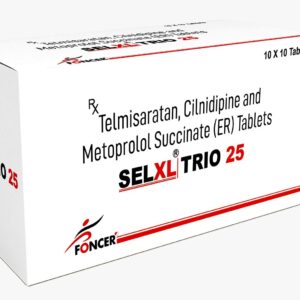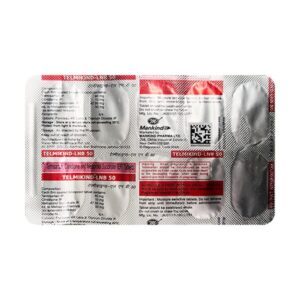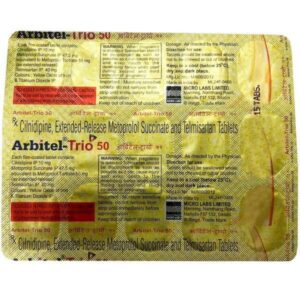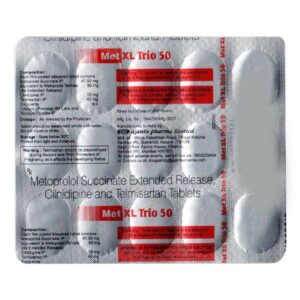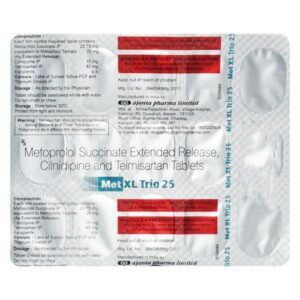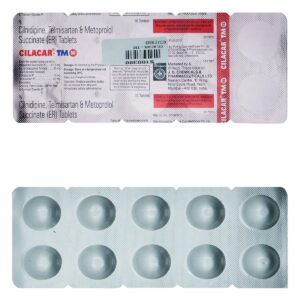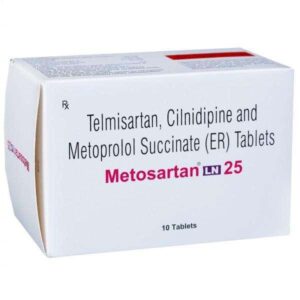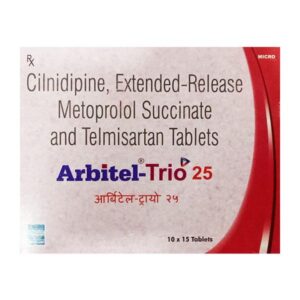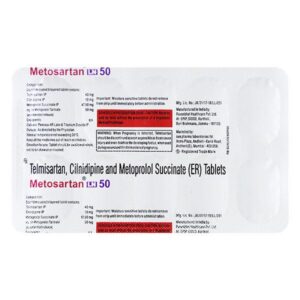METOPROLOL + TELMISARTAN + CILNIDIPINE
Metoprolol: Metoprolol is a prescription medication that belongs to a class of drugs called beta-blockers. It is commonly used to treat high blood pressure (hypertension), chest pain (angina), and heart rhythm disorders such as atrial fibrillation.
The mechanism of action of metoprolol involves blocking the action of certain chemicals in the body like adrenaline, which can increase heart rate and blood pressure. By blocking these chemicals, metoprolol helps to lower blood pressure, reduce the workload on the heart, and improve blood flow through the arteries. It also helps to stabilize the heart rhythm in conditions such as atrial fibrillation.
Metoprolol is available in several formulations, including immediate-release tablets, extended-release tablets, and injection for intravenous use.
The usual starting dose for immediate-release metoprolol is 25 to 50 mg twice daily, and the dose can be gradually increased as needed. For extended-release metoprolol, the starting dose is usually 25 to 100 mg once daily. However, the specific dose and frequency may vary depending on the individual’s condition and response to treatment.
Like all medications, metoprolol can cause side effects. Common side effects may include tiredness, dizziness, slow heart rate, low blood pressure, and gastrointestinal symptoms like nausea, vomiting, and diarrhea. Some people may also experience sleep disturbances, depression, and cold hands and feet.
More serious side effects can occur, although they are rare. These may include allergic reactions, difficulty breathing, chest pain, or worsening symptoms of heart failure. It is important to seek immediate medical attention if any of these occur.
It is worth noting that metoprolol can interact with other medications, so it is important to inform your healthcare provider about all the medications you are taking before starting treatment with metoprolol. Additionally, it is not recommended to suddenly stop taking metoprolol without consulting with your healthcare provider, as it may cause a rebound increase in heart rate and blood pressure.
Telmisartan: Telmisartan is a medication that is primarily used to treat high blood pressure (hypertension). It belongs to a class of drugs called angiotensin II receptor blockers (ARBs).
The main mechanism of action of Telmisartan is by blocking the action of angiotensin II, a hormone that causes blood vessels to constrict, leading to increased blood pressure. By blocking the angiotensin II receptor, Telmisartan helps to dilate blood vessels, reduce blood pressure, and improve blood flow.
The usual starting dose of Telmisartan for hypertension is 40 mg taken once daily. However, the dose may be adjusted by a healthcare professional based on the individual’s response and needs. It can be taken with or without food.
Common side effects of Telmisartan include headache, dizziness, flu-like symptoms, stomach pain, and diarrhea. Serious but rare side effects may include angioedema (swelling of the lips, face, throat), liver problems, low blood pressure, and allergic reactions. It is important to seek medical attention if any side effects become severe or persistent.
Telmisartan may also be prescribed to reduce the risk of heart attack, stroke, or death from cardiovascular causes in individuals with a history of cardiovascular disease or diabetes. Additionally, it can be used to treat diabetic kidney disease in individuals with type 2 diabetes and high blood pressure.
It is crucial to take Telmisartan as prescribed by a healthcare professional and to follow regular check-ups to monitor blood pressure and any potential side effects.
Cilnidipine: Cilnidipine is a calcium channel blocker used primarily to treat hypertension (high blood pressure). It is also sometimes used for the management of angina pectoris (chest pain).
The drug works by blocking the L-type calcium channels in the smooth muscle cells lining blood vessels. This action results in vasodilation, or widening of the blood vessels, which leads to a reduction in blood pressure. Unlike some other calcium channel blockers, cilnidipine also blocks the N-type calcium channels, which are involved in the release of neurotransmitters. This dual action may provide additional benefits in certain patients, such as those with hypertension and concomitant neuropathy.
The usual starting dose of cilnidipine for hypertension is 5 mg per day, which can be increased to 10 mg per day if necessary. It is typically taken orally once daily, with or without food. The dose may vary depending on the patient’s condition and response to the medication, so it is important to follow the prescribed instructions provided by the healthcare professional.
Common side effects of cilnidipine may include headache, dizziness, flushing, ankle swelling, palpitations, and gastrointestinal disturbances such as nausea, constipation, or diarrhea. These side effects are usually mild and transient. Less common side effects may include fatigue, muscle cramps, rash, or hypersensitivity reactions. If any severe or persistent side effects occur, it is important to seek medical advice.
Cilnidipine may interact with certain medications, so it is important to inform the healthcare provider about all other drugs being taken, including over-the-counter medications, supplements, and herbal products. It is also essential to disclose any existing medical conditions, such as liver or kidney disease, before starting cilnidipine therapy.
Overall, Cilnidipine is an effective medication for the management of hypertension and can provide additional benefits in certain patients. However, it is essential to use the drug under medical supervision and follow the prescribed dosage to minimize the risk of side effects.

